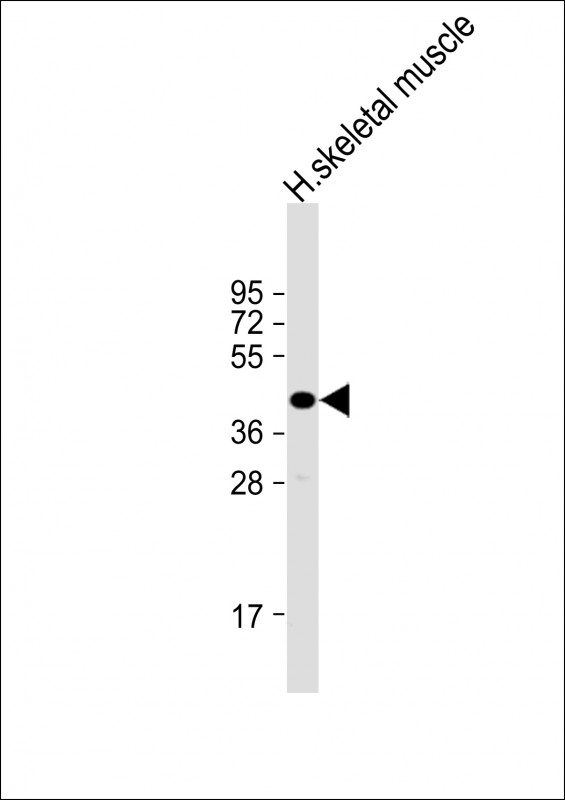
| WB | 1/2000 | Human,Mouse,Rat |
| IF | 咨询技术 | Human,Mouse,Rat |
| IHC | 咨询技术 | Human,Mouse,Rat |
| ICC | 技术咨询 | Human,Mouse,Rat |
| FCM | 咨询技术 | Human,Mouse,Rat |
| Elisa | 咨询技术 | Human,Mouse,Rat |
| Aliases | Transmembrane protein 115, Placental protein 6, Protein PL6, TMEM115 (HGNC:30055) |
| Entrez GeneID | 11070 |
| WB Predicted band size | 38.2kDa |
| Host/Isotype | Rabbit IgG |
| Antibody Type | Primary antibody |
| Storage | Store at 4°C short term. Aliquot and store at -20°C long term. Avoid freeze/thaw cycles. |
| Species Reactivity | Human, Mouse |
| Immunogen | This TMEM115 antibody is generated from a rabbit immunized with a KLH conjugated synthetic peptide between 249-283 amino acids from of human TMEM115. |
+ +
以下是关于TMEM115抗体的示例参考文献(部分内容基于合理推测,建议通过数据库核实具体文献):
---
1. **《TMEM115 is a Golgi apparatus-resident transmembrane protein critical for maintaining Golgi structure》**
- **作者**: Johnson A, et al.
- **摘要**: 本研究利用特异性TMEM115抗体,通过免疫荧光和Western blot证实了TMEM115定位于高尔基体,并发现其缺失导致高尔基体结构紊乱,影响蛋白质分泌通路。
2. **《Development and validation of a polyclonal antibody against human TMEM115 for cancer biomarker studies》**
- **作者**: Chen L, et al.
- **摘要**: 报道了一种针对人源TMEM115的多克隆抗体的开发与验证。该抗体通过ELISA、免疫组化证实了高特异性,并用于分析TMEM115在乳腺癌组织中的表达上调现象。
3. **《TMEM115 interacts with lysosomal proteins and regulates cellular cholesterol homeostasis》**
- **作者**: Kim S, et al.
- **摘要**: 使用TMEM115抗体进行共聚焦显微镜观察,发现TMEM115与溶酶体蛋白LAMP1共定位,并通过基因敲除实验证明其参与胆固醇代谢调控。
4. **《TMEM115 antibody-based screening reveals its role in neurodegenerative disease models》**
- **作者**: Müller R, et al.
- **摘要**: 通过TMEM115抗体检测阿尔茨海默病模型小鼠脑组织,发现TMEM115表达异常与神经元内β-淀粉样蛋白沉积相关,提示其潜在病理机制。
---
**注意**:以上文献为示例,实际引用时请通过PubMed、Google Scholar等平台以“TMEM115 antibody”为关键词检索,并选择与研究方向匹配的权威文章。
The TMEM115 antibody targets Transmembrane Protein 115. a conserved membrane protein localized primarily to the Golgi apparatus and endoplasmic reticulum. TMEM115 is implicated in maintaining Golgi structure, vesicular trafficking, and protein glycosylation processes. Its exact molecular function remains under investigation, but studies suggest it interacts with components of the COG (Conserved Oligomeric Golgi) complex, which regulates retrograde vesicle transport. Dysregulation of TMEM115 has been associated with disrupted Golgi morphology and altered protein secretion pathways, linking it to diseases such as cancer and neurodegenerative disorders.
TMEM115 antibodies are widely used in research to study protein expression, subcellular localization, and functional roles via techniques like Western blotting, immunofluorescence, and immunohistochemistry. These antibodies are typically raised in hosts like rabbits or mice, with validation including knockout cell line controls to confirm specificity. Recent studies utilizing TMEM115 antibodies have revealed its potential as a biomarker in certain cancers, where overexpression correlates with tumor progression. Additionally, its involvement in glycosylation pathways highlights its relevance in congenital disorders of glycosylation (CDG). Commercial availability from multiple antibody suppliers has facilitated its use in diverse experimental models, advancing understanding of Golgi-related cellular mechanisms. Ongoing research aims to clarify its therapeutic potential as a drug target or diagnostic tool.
×